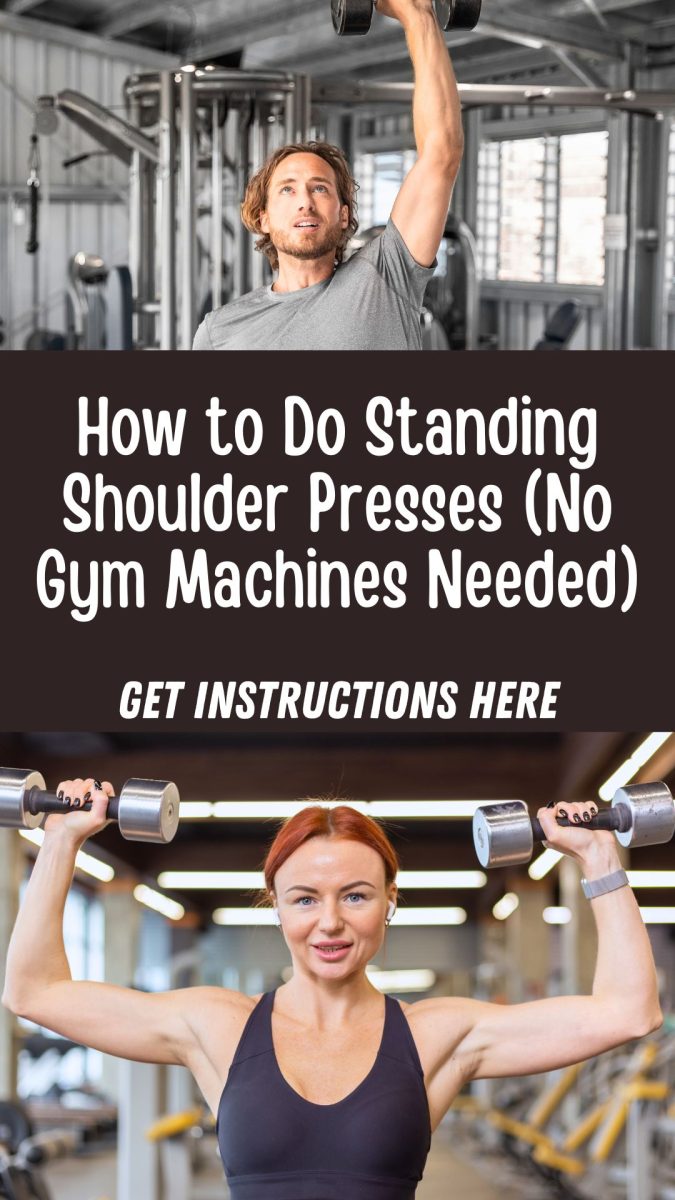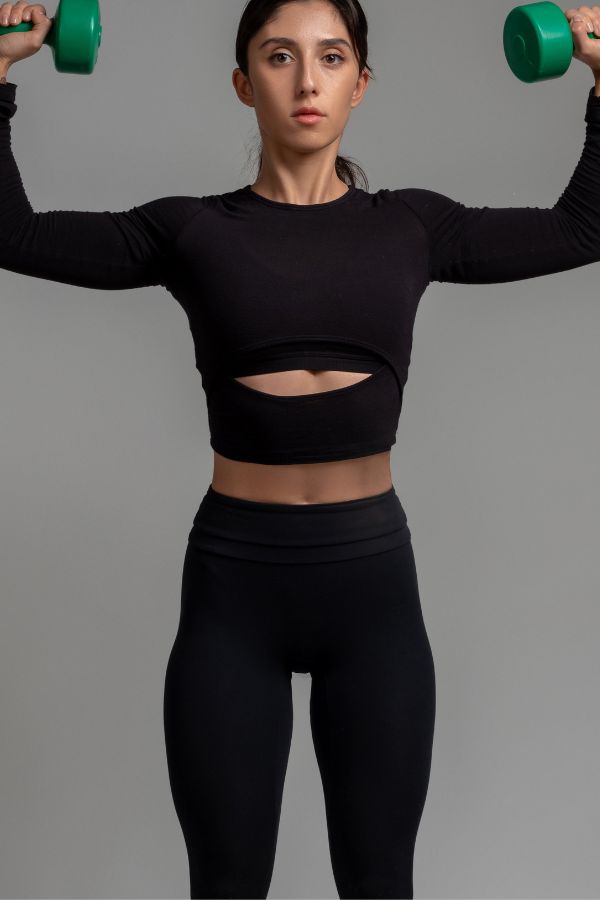When it comes to building strong, functional shoulders, the standing shoulder presses are one of the best exercises out there. You don’t need a fancy machine or a gym membership, just a pair of dumbbells, a barbell, or even resistance bands.

This powerful move strengthens your deltoids, core, upper back, and arms while improving your posture and shoulder mobility.
What Is a Standing Shoulder Press?
The standing shoulder press, sometimes called the overhead press, is a compound upper-body exercise that involves pressing weight vertically from shoulder height to above the head. Unlike machine-based presses, standing presses require you to stabilize your core and balance the load, which leads to better strength gains and functional fitness.
This movement primarily targets the shoulder muscles (deltoids), but it also works the triceps, trapezius, and core muscles to keep you balanced and steady throughout the lift.
Benefits of the Standing Shoulder Press
Standing shoulder presses offer a wide range of benefits, especially for those focused on overall strength, injury prevention, and athletic performance:
● Strengthens all three heads of the deltoid (front, side, and rear)
● Engages the core and lower back for stability
● Improves posture by strengthening the upper back and shoulders
● Increases functional upper body strength for lifting and carrying
● Can be performed anywhere—home, outdoors, or the gym
Because this is a standing exercise, your body is forced to work as a system, which mimics real-life movements and supports better long-term health and performance.

What You Need to Get Started
One of the best things about the standing shoulder press is how versatile it is. Here are your equipment options:
● Dumbbells: Great for home workouts and allow for a natural range of motion.
● Barbell: Ideal for lifting heavier weights and progressive overload.
● Resistance Bands: A low-impact, joint-friendly option.
● Kettlebells or Household Items: If you don’t have gym gear, even water jugs or canned goods can work in a pinch.
A mat or soft surface and access to a mirror or phone camera to check form can also be helpful.

How to Do a Standing Shoulder Press With Dumbbells
1. Starting Position
Stand tall with your feet shoulder-width apart. Hold a dumbbell in each hand at shoulder height with your palms facing forward. Engage your core by tightening your abs and glutes. This helps protect your lower back and keeps you stable.
2. Press Up
Exhale as you press the dumbbells overhead in a smooth, controlled motion. Keep your elbows slightly in front of your shoulders and don’t lock your arms at the top.
3. Pause at the Top
Once your arms are fully extended overhead, pause for a moment. Your biceps should be near your ears, and your spine should remain neutral (avoid arching your lower back).
4. Lower Back Down
Inhale as you slowly lower the weights back to shoulder level. Keep the motion controlled and avoid letting the dumbbells drop or crash down.
Common Mistakes to Avoid
To stay safe and get the most out of your shoulder press, watch for these common errors:
● Overarching the Lower Back: This usually happens if the weight is too heavy or your core isn’t engaged. Tighten your abs and glutes to stay stable.
● Elbows Flaring Too Wide: Keep elbows slightly in front of your body for proper shoulder alignment.
● Using Momentum: Don’t swing or bounce the weights. Controlled movement is more effective and safer.
● Shrugging Shoulders: Focus on pressing with your delts, not your traps. Keep shoulders down and relaxed.
Modifications for Different Fitness Levels
The standing shoulder press can be adapted to suit beginners and more advanced lifters alike.
For Beginners:
Start with lighter dumbbells or use water bottles if needed. Perform the movement seated to reduce the stability demand and help build strength.
For Intermediate Lifters:
Use a barbell to challenge your upper-body strength and stability. You can also alternate arms or try a single-arm press to focus on unilateral strength and balance.
For Advanced Lifters:
Add tempo (pause at the top or slow down the eccentric/lowering phase) or combine with a squat for a full-body compound movement. You can also progress to the push press, using a small dip of your knees to drive heavier weights overhead.
Barbell Standing Shoulder Press Tips
If you’re using a barbell, the technique is slightly different:
● Grip the bar slightly wider than shoulder-width
● Keep your wrists straight and elbows slightly forward
● Press the bar in a straight line above your head, not out in front
● Avoid leaning back or arching to compensate for heavy weight
A barbell press is great for building max strength, but it requires more shoulder mobility and upper back stability.
Resistance Band Variation
If you don’t have weights, resistance bands are a great alternative. Stand on the band with both feet and hold the handles or ends at shoulder height. Press overhead just like you would with dumbbells. Bands are excellent for joint health and offer increasing resistance through the range of motion.
How Often Should You Do Shoulder Presses?
Shoulder presses can be done 1–3 times per week, depending on your training split and goals. For general strength and fitness, include them on your upper-body or push days. If you’re lifting heavy, allow at least 48 hours between sessions to give your muscles time to recover and grow.
Sample Sets and Reps
● For Strength: 4 sets of 4–6 reps with heavier weights
● For Muscle Growth (Hypertrophy): 3–4 sets of 8–12 reps
● For Endurance or Toning: 2–3 sets of 12–15+ reps with lighter weights
Always prioritize form over weight, especially with overhead movements that put pressure on your shoulders and spine.
Muscles Worked in the Standing Shoulder Press
This move primarily targets:
● Deltoids (shoulders): Especially the front and side heads
● Triceps: Assist in the pressing movement
● Trapezius and Upper Back: Stabilize the shoulders
● Core (abs and lower back): Keep your torso upright and balanced
Because it’s a standing movement, it also lightly activates the glutes, hamstrings, and even your calves as you stabilize through the press.
Why No Machines?
While shoulder press machines can be helpful for beginners or isolation work, they don’t engage the core or stabilizing muscles as effectively. Machine presses also lock you into a fixed range of motion, which might not fit your natural joint movement. By doing standing shoulder presses with free weights, you not only build strength but also improve coordination, balance, and joint mobility—all key components of real-life fitness.
More Upper Body Strength Exercises
For more ideas to increase upper body strength, check these out:
- Pushup Workout for Beginners
- Planking Exercises for Beginners
- Bodyweight Lunges for Beginners
- How to Deadlift for Beginners
- The Ultimate Guide to Bicep Curls for Muscle Growth





No comments! Be the first commenter?